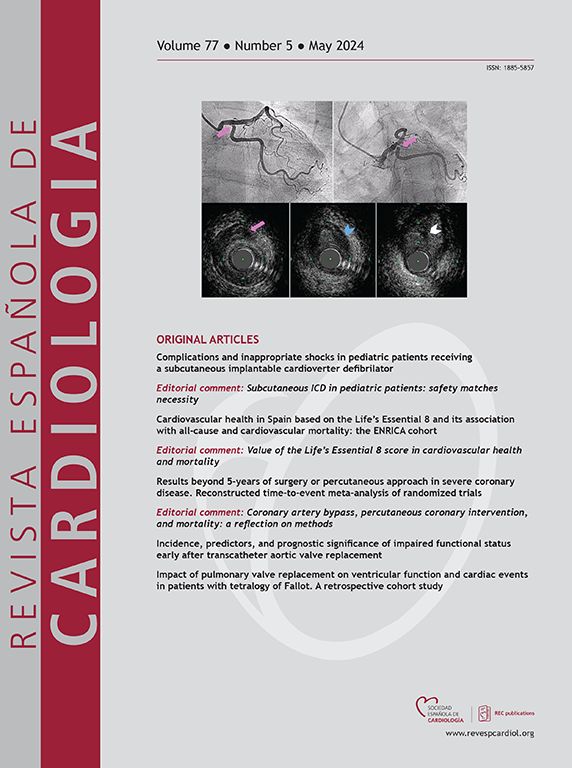经皮植入主动脉瓣假体后淀粉样变对预后的影响
IF 5.9
2区 医学
Q2 Medicine
引用次数: 0
摘要
简介和目的淀粉样变性对经导管主动脉瓣植入术(TAVI)后预后影响的数据有限。本研究的目的是评估淀粉样变性患者tavi后1年不良事件的风险。方法2005 ~ 2023年TAVI患者根据有无淀粉样变分为两组。主要终点是复合终点的1年风险:心力衰竭(HF)、缺血性卒中、起搏器植入、急性肾损伤和全因死亡。次要结果评估了组合的各个组成部分。倾向评分匹配用于平衡各组,Cox回归用于评估淀粉样变性相关不良结局的风险。对早期(30天)和长期(30天至1年)随访的综合结果进行分析。结果589例TAVI淀粉样变患者(平均年龄78.9±8.2岁,女性31.9%)与5296例无淀粉样变患者(平均年龄78.1±8.8岁,女性40.3%)的数据进行比较。倾向评分匹配后,淀粉样变性患者1年不良事件发生风险显著增高(HR, 1.27; 95%CI, 1.08-1.49)。具体来说,淀粉样变患者发生HF的风险增加(HR, 1.37; 95%CI, 1.10-1.70)。在长期随访中,卒中风险(HR, 1.67; 95%CI, 1.16-2.40)和起搏器植入(HR, 2.25; 95%CI, 1.15-4.41)较高,而急性肾损伤和全因死亡率两组间无差异。结论:在接受TAVI的患者中,淀粉样变患者发生不良事件的风险更高,特别是HF,并且长期内起搏器植入和卒中的风险增加。本文章由计算机程序翻译,如有差异,请以英文原文为准。
Impacto de la amiloidosis en los resultados tras el implante percutáneo de prótesis valvular aórtica
Introduction and objectives
Data on the impact of amyloidosis on outcomes after transcatheter aortic valve implantation (TAVI) are limited. The objective of this study was to evaluate the 1-year risk of adverse events post-TAVI in patients with amyloidosis.
Methods
Patients undergoing TAVI (between 2005 and 2023) were categorized into 2 groups based on the presence of amyloidosis. The primary outcome was the 1-year risk of a composite endpoint: heart failure (HF), ischemic stroke, pacemaker implantation, acute kidney injury, and all-cause death. Secondary outcomes assessed the individual components of the composite. Propensity score matching was used to balance the groups, and Cox regression was used to assess the risk of adverse outcomes associated with amyloidosis. Composite outcomes were analyzed for early (30-days) and long-term (30-days to 1 year) follow-up.
Results
Data from 589 TAVI patients with amyloidosis (mean age 78.9 ± 8.2 years, 31.9% female) were compared with 52 296 individuals without amyloidosis (mean age 78.1 ± 8.8 years, 40.3% female). After propensity score matching, patients with amyloidosis had a significantly higher 1-year risk of adverse events (HR, 1.27; 95%CI, 1.08-1.49). Specifically, patients with amyloidosis showed an increased risk of HF (HR, 1.37; 95%CI, 1.10-1.70). Stroke risk (HR, 1.67; 95%CI, 1.16–2.40) and pacemaker implantation (HR, 2.25; 95%CI, 1.15-4.41) were higher during long-term follow-up, while no differences were found for acute kidney injury or all-cause mortality between the 2 groups.
Conclusions
Among patients undergoing TAVI, those with amyloidosis are at a higher risk of adverse events, particularly HF, and have an increased risk of pacemaker implantation and stroke in the long-term.
求助全文
通过发布文献求助,成功后即可免费获取论文全文。
去求助
来源期刊

Revista espanola de cardiologia
医学-心血管系统
CiteScore
4.20
自引率
13.60%
发文量
257
审稿时长
28 days
期刊介绍:
Revista Española de Cardiología, Revista bilingüe científica internacional, dedicada a las enfermedades cardiovasculares, es la publicación oficial de la Sociedad Española de Cardiología.
 求助内容:
求助内容: 应助结果提醒方式:
应助结果提醒方式:


